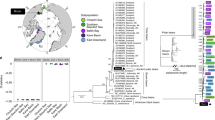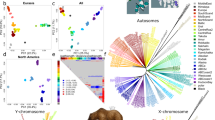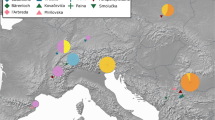Abstract
Although many large mammal species went extinct at the end of the Pleistocene epoch, their DNA may persist due to past episodes of interspecies admixture. However, direct empirical evidence of the persistence of ancient alleles remains scarce. Here, we present multifold coverage genomic data from four Late Pleistocene cave bears (Ursus spelaeus complex) and show that cave bears hybridized with brown bears (Ursus arctos) during the Pleistocene. We develop an approach to assess both the directionality and relative timing of gene flow. We find that segments of cave bear DNA still persist in the genomes of living brown bears, with cave bears contributing 0.9 to 2.4% of the genomes of all brown bears investigated. Our results show that even though extinction is typically considered as absolute, following admixture, fragments of the gene pool of extinct species can survive for tens of thousands of years in the genomes of extant recipient species.
This is a preview of subscription content, access via your institution
Access options
Access Nature and 54 other Nature Portfolio journals
Get Nature+, our best-value online-access subscription
$29.99 / 30 days
cancel any time
Subscribe to this journal
Receive 12 digital issues and online access to articles
$119.00 per year
only $9.92 per issue
Buy this article
- Purchase on Springer Link
- Instant access to full article PDF
Prices may be subject to local taxes which are calculated during checkout



Similar content being viewed by others
References
Shurtliff, Q. R. Mammalian hybrid zones: a review. Mamm. Rev. 43, 1–21 (2013).
Green, R. E. et al. A draft sequence of the Neandertal genome. Science 328, 710–722 (2010).
Meyer, M. et al. A high-coverage genome sequence from an archaic Denisovan individual. Science 338, 222–226 (2012).
Reich, D. et al. Genetic history of an archaic hominin group from Denisova Cave in Siberia. Nature 468, 1053–1060 (2010).
Baca, M. et al. Retreat and extinction of the Late Pleistocene cave bear (Ursus spelaeus sensu lato). Naturwissenschaften 103, 11–12 (2016).
Stiller, M. et al. Withering away—25,000 years of genetic decline preceded cave bear extinction. Mol. Biol. Evol. 27, 975–978 (2010).
Fortes, G. G. et al. Ancient DNA reveals differences in behaviour and sociality between brown bears and extinct cave bears. Mol. Ecol. 25, 4907–4918 (2016).
Noonan, J. P. et al. Genomic sequencing of Pleistocene cave bears. Science 309, 597–599 (2005).
Krause, J. et al. Mitochondrial genomes reveal an explosive radiation of extinct and extant bears near the Miocene–Pliocene boundary. Evol. Biol. 8, 220 (2008).
Cahill, J. A. et al. Genomic evidence of geographically widespread effect of gene flow from polar bears into brown bears. Mol. Ecol. 24, 1205–1217 (2015).
Cahill, J. A. et al. Genomic evidence of globally widespread admixture from polar bears into brown bears during the last ice age. Mol. Biol. Evol. 35, 1120–1129 (2010).
Cahill, J. A. et al. Genomic evidence for island population conversion resolves conflicting theories of polar bear evolution. PLoS Genet. 9, e1003345 (2013).
Kumar, V. et al. The evolutionary history of bears is shaped by gene flow across species. Sci. Rep. 7, 46487 (2017).
Kurtén, B. Pleistocene Mammals of Europe (Weidenfeld & Nicholson, London, 1968).
Kurtén, B. The Cave Bear Story: Life and Death of a Vanished Animal (Columbia Univ. Press, New York, NY, 1976).
Stiller, M. et al. Mitochondrial DNA diversity and evolution of the Pleistocene cave bear complex. Quat. Int. 339, 224–231 (2014).
Barlow, A. et al. Massive influence of DNA isolation and library preparation approaches on palaeogenomic sequencing data. Preprint at https://doi.org/10.1101/075911 (2016).
Pinhasi, R. et al. Middle Palaeolithic human occupation of the high altitude region of Hovk-1, Armenia. Quat. Sci. Rev. 30, 3846–3857 (2011).
Li, R. et al. The sequence and de novo assembly of the giant panda genome. Nature 463, 311–317 (2010).
Baryshnikov, G. F. & Puzachenko, A. Y. Craniometrical variability in the cave bears (Carnivora, Ursidae): multivariate comparative analysis. Quat. Int. 245, 350–368 (2011).
Durand, E. Y., Patterson, N., Reich, D. & Slatkin, M. Testing for ancient admixture between closely related populations. Mol. Biol. Evol. 28, 2239–2252 (2011).
Pease, J. B. & Hahn, M. W. Detection and polarization of introgression in a five-taxon phylogeny. Syst. Biol. 64, 651–662 (2015).
Węcek, K. et al. Complex admixture preceded and followed the extinction of wisent in the wild. Mol. Biol. Evol. 34, 598–612 (2017).
Dannemann, M., Andrés, A. M. & Kelso, J. Introgression of Neandertal- and Denisovan-like haplotypes contributes to adaptive variation in human toll-like receptors. Am. J. Hum. Genet. 98, 22–33 (2016).
Racimo, F., Sankararaman, S., Nielsen, R. & Huerta-Sánchez, E. Evidence for archaic adaptive introgression in humans. Nat. Rev. Genet. 16, 359–371 (2015).
Huerta-Sánchez, E. et al. Altitude adaptation in Tibetans caused by introgression of Denisovan-like DNA. Nature 512, 194–197 (2014).
Miao, B., Wang, Z. & Li, Y. Genomic analysis reveals hypoxia adaptation in the Tibetan mastiff by introgression of the gray wolf from the Tibetan plateau. Mol. Biol. Evol. 34, 734–743 (2017).
Sankararaman, S., Mallick, S., Patterson, N. & Reich, D. The combined landscape of Denisovan and Neanderthal ancestry in present-day humans. Curr. Biol. 26, 1241–1247 (2016).
Lohse, K. & Frantz, L. A. F. Neandertal admixture in Eurasia confirmed by maximum-likelihood analysis of three genomes. Genetics 196, 1241–1251 (2014).
Gutenkunst, R. N., Hernandez, R. D., Williamson, S. H. & Bustamante, C. D. Inferring the joint demographic history of multiple populations from multidimensional SNP frequency data. PLoS Genet. 5, e1000695 (2009).
Pickrell, J. K. & Pritchard, J. K. Inference of population splits and mixtures from genome-wide allele frequency data. PLoS Genet. 8, e1002967 (2012).
Fulton, T. L. in Ancient DNA: Methods and Protocols Vol. 840 (eds. Shapiro, B. & Hofreiter, M.) 1–11 (Springer, New York, NY, 2012).
Dabney, J. et al. Complete mitochondrial genome sequence of a Middle Pleistocene cave bear reconstructed from ultrashort DNA fragments. Proc. Natl Acad. Sci. USA 110, 15758–15763 (2013).
Dabney, J., Meyer, M. & Pääbo, S. Ancient DNA damage. Cold Spring Harb. Perspect. Biol. 5, a012567 (2013).
Gansauge, M.-T. & Meyer, M. Single-stranded DNA library preparation for the sequencing of ancient or damaged DNA. Nat. Protoc. 8, 737–748 (2013).
Li, B., Zhang, G., Willerslev, E., Wang, J. & Wang, J. Genomic data from the polar bear (Ursus maritimus). GigaScience http://gigadb.org/dataset/100008 (2011).
Ginolhac, A., Rasmussen, M., Gilbert, M. T. P., Willerslev, E. & Orlando, L. mapDamage: testing for damage patterns in ancient DNA sequences. Bioinformatics 27, 2153–2155 (2011).
Meyer, M. & Kircher, M. Illumina sequencing library preparation for highly multiplexed target capture and sequencing. Cold Spring Harb. Protoc. 2010, pdb.prot5448 (2010).
Fortes, G. G. & Paijmans, J. L. A. in Whole Genome Amplification (ed. Kroneis, T.) 179–195 (Humana, New York, NY, 2015).
St John, J. SeqPrepv1.1 (2013); https://github.com/jstjon/SeqPrep
Li, H. & Durbin, R. Fast and accurate short read alignment with Burrows–Wheeler transform. Bioinformatics 25, 1754–1760 (2009).
Li, H. et al. The sequence alignment/map format and SAMtools. Bioinformatics 25, 2078–2079 (2009).
Stamatakis, A. RAxML version 8: a tool for phylogenetic analysis and post-analysis of large phylogenies. Bioinformatics 30, 1312–1313 (2014).
McKenna, A. et al. The genome analysis toolkit: a mapreduce framework for analyzing next-generation DNA sequencing data. Genome Res. 20, 1297–1303 (2010).
Edgar, R. C. MUSCLE: multiple sequence alignment with high accuracy and high throughput. Nucleic Acids Res. 32, 1792–1797 (2004).
Miller, M. A., Pfeiffer, W. & Schwartz, T. in 2010 Gateway Computing Environments Workshop (GCE) 1–8 (IEEE, 2010); https://doi.org/10.1109/GCE.2010.5676129
Beaumont, M. A., Zhang, W. & Balding, D. J. Approximate Bayesian computation in population genetics. Genetics 162, 2025–2035 (2002).
Huerta-Cepas, J., Serra, F. & Bork, P. ETE 3: reconstruction, analysis, and visualization of phylogenomic data. Mol. Biol. Evol. 33, 1635–1638 (2016).
Stajich, J. E. et al. The Bioperl toolkit: Perl modules for the life sciences. Genome Res. 12, 1611–1618 (2002).
R Core Team. R: a language and environment for statistical computing (R Foundation for Statistical Computing, Vienna, 2014); http://www.r-project.org/
Acknowledgements
This work was funded by European Research Council (ERC) consolidator grant ‘gene flow’ 310763 to M.H. G.G.F. and R.P. were supported by ERC starting grant 263441 to R.P. A.G.-d’A. and A.G.-V. were supported by research project CGL2014-57209-P of the Spanish Ministry of Economy and Competitiveness to A.G.-d’A. J.A.C. and B.S. were supported by a grant from the Gordon and Betty Moore Foundation (GBMF-3804) and NSF ARC-1417036 to B.S. U.S. was supported by grant IUT20-32 from the Estonian Ministry of Education and Research, and P.A. by the Estonian Science Foundation DoRa programme. We thank the regional governments of Asturias and Castilla y León, in Spain, for providing tissue samples of Cantabrian bears. The authors would like to acknowledge support from Science for Life Laboratory, the National Genomics Infrastructure (NGI), Sweden, the Knut and Alice Wallenberg Foundation and UPPMAX for providing assistance in massively parallel DNA sequencing and computational infrastructure.
Author information
Authors and Affiliations
Contributions
A.B. and M.H. conceived the study; A.B., G.X., G.G.F., L.D. and P.A. performed laboratory work; A.B., J.A.C., S.H., C.T. and J.L.A.P. performed data analysis; A.B., J.A.C., S.H., C.T., J.L.A.P., G.X., G.B., R.P., L.D., B.S., M.S. and M.H. interpreted the results; A.B., J.A.C., S.H., C.T., J.L.A.P., B.S., M.S. and M.H. provided theoretical discussion of methodological developments; M.H., B.S. and M.S. supervised work carried out in their respective research groups; A.B., J.A.C. and M.H. wrote the manuscript; G.R., C.F., A.G.-d’A., A.G.-V., M.M., U.S., P.A., T.S., B.G., G.B.-O. and R.P. selected samples; G.B. contributed data; M.H., R.P., B.S. and A.G.-d’A. obtained funding. All authors read, gave comments and helped to revise the final version of the manuscript.
Corresponding author
Ethics declarations
Competing interests
The authors declare no competing interests.
Additional information
Publisher’s note: Springer Nature remains neutral with regard to jurisdictional claims in published maps and institutional affiliations.
Supplementary information
Supplementary Tables and Figures
Supplementary information, figures and tables
Supplementary Data 1
D statistic tests for unequal allele sharing between two brown or polar bears and a cave bear candidate introgressor
Supplementary Data 2
D statistic tests for unequal allele sharing between two cave bears and a polar bear or brown bear candidate introgressor
Supplementary Data 3
D statistic tests inconsistent with the species tree as a measure of clade differentiation — comparisons within European cave bears and European cave bears relative to the Caucasus cave bear kudarensis
Supplementary Data 4
D statistic tests inconsistent with the species tree as a measure of clade differentiation — comparisons polar bears relative to brown bears, and brown bears relative to polar bears
Supplementary Data 5
f estimates of cave bear ancestry in brown relative polar bears, and among polar bears
Supplementary Data 6
f estimates of brown bear ancestry in European cave bears, relative to the Caucasus cave bear kudarensis
Rights and permissions
About this article
Cite this article
Barlow, A., Cahill, J.A., Hartmann, S. et al. Partial genomic survival of cave bears in living brown bears. Nat Ecol Evol 2, 1563–1570 (2018). https://doi.org/10.1038/s41559-018-0654-8
Received:
Accepted:
Published:
Issue Date:
DOI: https://doi.org/10.1038/s41559-018-0654-8
This article is cited by
-
Recent increase in species-wide diversity after interspecies introgression in the highly endangered Iberian lynx
Nature Ecology & Evolution (2024)
-
Range-wide whole-genome resequencing of the brown bear reveals drivers of intraspecies divergence
Communications Biology (2023)
-
How to Elucidate Functional Genomic Differences between Extinct Organisms and Their Extant Relatives
Journal of Earth Science (2023)
-
Genomic variation from an extinct species is retained in the extant radiation following speciation reversal
Nature Ecology & Evolution (2022)
-
A polar bear paleogenome reveals extensive ancient gene flow from polar bears into brown bears
Nature Ecology & Evolution (2022)



